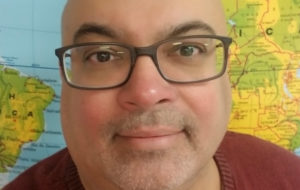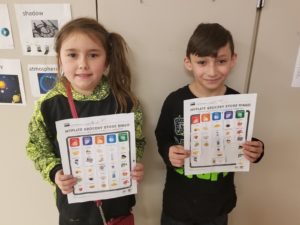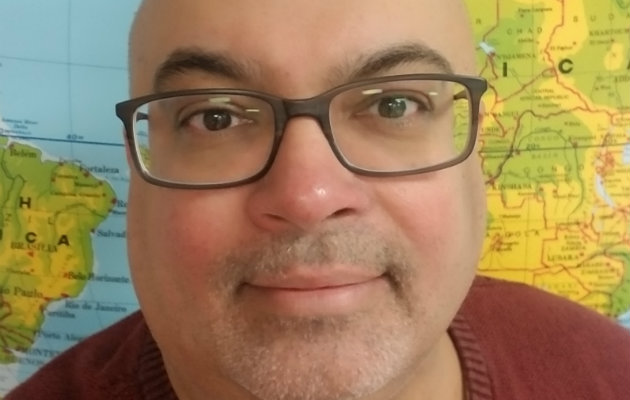The Van Andel Education Institute strives to be a place where teachers of all backgrounds are recognized and empowered. Our Blue Apple Teacher Feature is a bi-weekly blog dedicated to highlighting exceptional educators who are building classrooms dedicated to curiosity, collaboration, and creativity! Interested to know what obstacles students and teachers are facing today? Want to learn the modern techniques educators employ to foster imagination and growth? Then say hello to Edwin Maisonet, an elementary and STEM teacher from Illinois, and lead author of the nutrition-based project, Food for Thought!

Edwin Maisonet received his B.A. in Elementary Education from Northern Illinois University. He subsequently earned a Masters Degree in Teacher Leadership and Life Science from Aurora University. In the past, he taught self-contained elementary classrooms in grades 2-6. Currently, Edwin is employed by Aurora West School District 129, and serves as the STEM teacher at McCleery Elementary School. His hobbies included English literature, playing the electric bass, and talking science.
Why did you get involved in education?
First, the how. Completely by accident. I was studying at Waubonsee Community College and had just decided I wanted to become a museum curator, as I always had an affinity for history. I had a sister working in administration at the time. Her boss was looking for a bilingual teacher assistant for a school on the west side of Aurora. He asked me if I wanted a job. I hesitated, said yes, and started work the following week. I had the opportunity to work with a teacher, originally from Texas, named Laura Sanchez. Mrs. Sanchez allowed me to share ideas and contribute in a way that made me feel like an integral part of the classroom. Needless to say, I was hooked. I decided to major in education, headed to Northern Illinois University, and got my degree.
What do you believe are the greatest challenges facing teachers today?
I feel some of the greatest challenges facing teachers today are:
- An increase in content matter with no increase in student contact time.
- Integration of new technologies that provide relevant and meaningful learning experiences, and not just substitution for old methods of instruction.
- The focus on high-stakes testing in education.
- Retention of high-quality newer teachers in many districts due to pay, interest, etc.
- Political entities seeking to privatize education and usurp teacher unions.
What do you believe are the greatest challenges facing students today?
Some of the greatest challenges facing students include:
- Access to technologies that many districts take for granted.
- Inequality in funding and basic resources (books, materials, etc.) in many districts.
- Lack of alternative programs for students who may have futuristic interests or goals that do not necessarily involve college.
What tools have you found most useful for inspiring students to think critically and creatively?
I am lucky to be in a school district with 1:1 technology. My reading enrichment group has access to an online comic maker that has really brought on their creative sides. They are able to use the site in a variety of ways. For example, story summaries or retellings, vocabulary extensions, first person writing, just to name a few.
Our groups also utilize software to create hilarious vocabulary memes based on the Caesar’s English Vocabulary program!
Lastly, our STEM challenges really help connect concepts like supply lines, resources, and costs to the manufacturing of products, such as earthquake proof structures.
How would you like to see education change in the next ten years?
Personally, I would like to see more of an emphasis on science, social sciences, and math. I would like to see an increase in informational reading over literature at the upper elementary level. Especially since reading is not really a content area. I really feel focusing on informational reading is such a game changer.
How can parents assist students in developing curiosity and iterative thinking?
Parents can assist students by taking their children to museums, libraries, and zoos, so that their children have an increase in background knowledge and wider array of interests. Parents can download STEM activities from web sites, and practice doing science with their children. Even watching quality science programming together can lead to great conversation and meaningful family time.
What is one of the most authentic learning experiences you’ve ever done with your students?
Actually, I can name two.
I have an activity I call the Mouse and the Milk Can Mystery. Students work within a story line framework to explain a phenomenon. In this case, how one mouse was able to escape a milk can with slick sides, while the other was not. In the end, students create an experiment in which they unwittingly make butter and explain the phenomenon.
The second activity is where students portray scientists who become stranded on a distant planet after searching for a new power source. Their only hope is to find a power source that will enable them to return to orbit. By the way, they only have 40 minutes of oxygen in their tanks. (I love that bit.) Students end up shooting gas-powered “rockets” from the materials they locate. It’s kind of like an escape room gone planetary.
What do you wish for each student?
I really wish that all students could receive a quality education wherever they live, and that they feel valued and encouraged to continue their educational growth after they leave our classrooms.

About the Project: Food for Thought
“I feel as if the creativity component was aided by the opportunity to provide a critical analysis of not just the recipes flavor, but also the nutritional data chefs provided to their classmates.” – Edwin Maisonet on Food for Thought!
We need to food to live, but are we making the best choices when it comes to nutrition? A healthy, well-balanced diet can help people achieve optimal health and reduce the risk of illness. Imagine if thousands of students just like yours, all around the country, made small changes to improve their lifestyles. It could add up to an incredible force for good!
Interested in learning how you can better impact the lives of students? Check out our webpage and stay tuned to meet more dynamic teachers!

